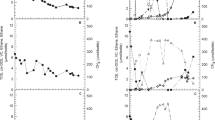Abstract
The ability of dehalogenating bacteria to compete with sulfate reducing bacteria forelectron donor was studied in microcosms that simulated groundwater contaminatedwith both chlorinated ethylenes and fuel hydrocarbon compounds. Results demonstratethat reductive dehalogenation of perchloroethylene to ethylene can proceed in thepresence of >100 mg l-1 sulfate. The hydrogen concentration, which was2.5 nM in the presence of approximately 150 mg l-1 sulfate and in the absence of chlorinated compounds, decreased to 0.7 nM during the dechlorination oftrichloroethylene and increased to 1.6 nM during the dechlorination ofcis-dichloroethylene and vinyl chloride. With only sediment associated donor(``historical'' donor) present, dechlorination of trichloroethylene proceededslowly to ethylene (on a time scale of several years). Addition of toluene, amodel hydrocarbon compound, stimulated dechlorination indirectly. Toluenedegradation was rapid and linked to sulfate utilization, and presumably formedfermentable substrates that served as hydrogen donors. Dehalogenation wasinhibited in soil free microcosms containing 5 mM sulfide, but inhibition wasnot observed when either aquifer sediment or 5 mM ferrous chloride was added.
Similar content being viewed by others
References
Bagley DM & Gossett JM (1990) Tetrachloroethene transforma-tion to trichloroethene and cis-1,-2-dichloroethene by sulfate-reducing enrichment cultures. Appl. Environ. Microbiol. 56: 2511-2516
Beller HR & Reinhard M (1995) The role of iron in enhancing anaerobic toluene degradation in sulfate-reducing enrichment cultures. Microbial Ecol. 30: 105-114
Beller HR, Spormann AM, Sharma PK, Cole JR & Reinhard M (1996) Isolation and characterization of a novel toluene-degrading, sulfate-reducing bacterium. Appl. Environ. Micro-biol. 62: 1188-1196
Boopathy R & Peters R (2001) Enhanced biotransformation of tri-chloroethylene under mixed electron accepting conditions. Curr. Microbiol. 42: 134-138
Bouwer EJ & McCarty PL (1983) Transformations of 1-and 2 carbon halogenated aliphatic organic compounds under meth-anogenic conditions. Appl. Environ. Microbiol. 45: 1286-1294
Cabirol N, Jacob F, Perrier J, Fouillet B & Chambon P (1998) Interaction between methanogenic and sulfate-reducing microor-ganisms during dechlorination of a high concentration of tetra-chloroethylene. J. Gen. Appl. Microbiol. 44: 297-301
Committee on Ground Water Cleanup Alternatives (Kavanaugh M.C., Chair) (1994) Alternatives for Ground Water Cleanup, National Academy Press, Washington, D.C.
De Bruin WP, Kotterman MJJ, Posthumus MA, Schraa G & Zehnder AJB (1992) Complete biological reductive transformation of tetrachloroethene to ethane. Appl. Environ. Microbiol. 58: 1996-2000
Edwards EA, Wills LE, Reinhard M & Grbic-Galic D (1992) Anaerobic degradation of toluene and xylene by aquifer mi-croorganisms under sulfate-reducing conditions. Appl. Environ. Microbiol. 58: 794-800
ESTCP (2001)http://www.estcp.org/documents/techdocs/Rabitt_Update.pdf.
Fennell DE, Gossett JM& Zinder SH (1997) Comparison of butyric acid, ethanol, lactic acid, and propionic acid as hydrogen donors for the reductive dechlorination of tetrachloroethene. Environ. Sci. Technol. 31: 918-926
Gossett JM(1987) Measurement of henry's law constants for C 1 and C 2 chlorinated hydrocarbons. Environ. Sci. Technol. 21: 202-208
Grbic-Galic D & Vogel TM (1987) Transformation of toluene and benzene by mixed methanogenic cultures. Appl. Environ. Microbiol. 53: 254-260
Harkness MR, Bracco AA, Brennan MJ, Jr., Deweerd KA & Spivack JL (1999) Use of bioaugmentation to stimulate com-plete reductive dechlorination of trichloroethene in Dover soil columns. Environ. Sci. Technol. 33: 1100-1109
He J, Sung Y, Dollhopf ME, Fathepure BZ, Tiedje JM & Löffler FE (2002) Acetate versus hydrogen as direct electron donors to stimulate the microbial reductive dechlorination process at chloroethene-contaminated sites. Environ. Sci. Techn. 36: 3945- 3952
Holliger C, Schraa G, Stams AJM & Zehnder AJB (1993) A highly purified enrichment culture couples the reductive dechlorination of tetrachloroethene to growth. Appl. Environ. Microbiol. 59: 2991-2997
Holliger C, Wohlfarth G & Diekert G (1998) Reductive dechlor-ination in the energy metabolism of anaerobic bacteria. FEMS Microbiol. Rev. 22: 383-398
Lee MD, Odom JM & Buchanan Jr. RJ (1998) New perspectives on microbial dehalogenation of chlorinated solvents: insights from the field. Ann. Rev. Microbiol. 52: 423-452
Löffler FE, Tiedje JM & Sanford RA (1999) Fraction of elec-trons consumed in electron acceptor reduction and hydrogen thresholds as indicators of halorespiratory physiology. Appl. Environ. Microbiol. 65: 4049-4056
Lovley DR & Goodwin S (1988) Hydrogen concentrations as an indicator of the predominant terminal electron-accepting reactions in aquatic sediments. Geochim. Cosmochim. Acta 52: 2993-3004
Lu XX, Tao S, Bosma T & Gerritse J (2001) Characteristic hydrogen concentrations for various redox processes in batch study. J. Environ. Sci. Health Part A-Toxic/Hazardous Subst. & Environ. Eng. 36: 1725-1734
Maymo-Gatell X, Chien YT, Gossett JM & Zinder SH (1997) Isolation of a bacterium that reductively dechlorinates tetra-chloroethene to ethane. Science 276: 1568-1571
Mazur CS & Jones WJ (2001) Hydrogen concentrations in sulfate-reducing estuarine sediments during PCE dehalogenation. Environ. Sci. Techn. 35: 4783-4788
Pavlostathis SG & Zhuang P (1993) Reductive dechlorination of chloroalkenes in microcosms developed with a field contaminated soil. Chemosphere 27: 585-595
Sewell GW & Gibson SA (1991) Stimulation of the reductive dechlorination of tetrachloroethene in anaerobic aquifer microcosms by the addition of toluene. Environ. Sci. & Technol. 25: 982-984
Stumm W & Morgan JJ (1996) Aquatic Chemistry, third edition. John Wiley, New York
Yang Y & McCarty PL (1998) Competition for hydrogen within a chlorinated solvent dehalogenating anaerobic mixed culture. Environ. Sci. Technol. 32: 3591-3597
Yang Y & McCarty PL (2000) Biomass, oleate, and other possible substrates for chloroethene reductive dehalogenation. Bioremediation J. 4: 125-133.
Rights and permissions
About this article
Cite this article
Hoelen, T., Reinhard, M. Complete Biological Dehalogenation of Chlorinated Ethylenes in Sulfate Containing Groundwater. Biodegradation 15, 395–403 (2004). https://doi.org/10.1023/B:BIOD.0000044592.33729.d6
Issue Date:
DOI: https://doi.org/10.1023/B:BIOD.0000044592.33729.d6




